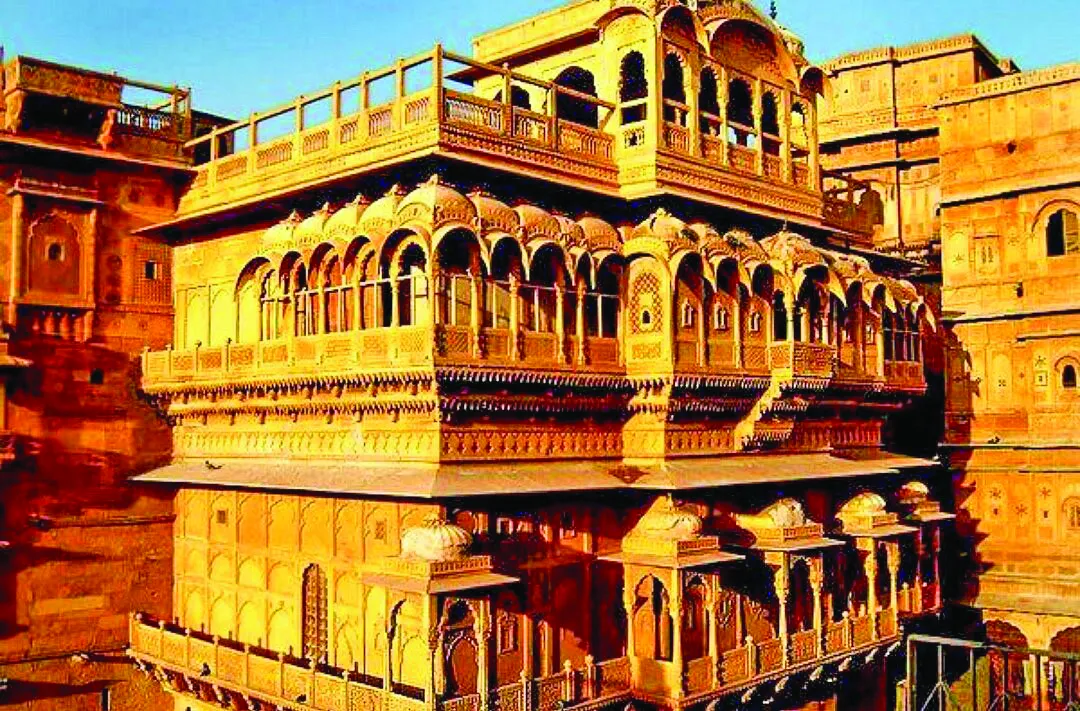Garba and Gujarat are inter-twined with each other as intimately as hand to glove and Dandiya to the Raas. A lyrical, sublime form of dance, Garba lights up every nook and cranny of the city of Baroda, what with streets filling up with women and men dressed in their ceremonial best hopping from one garba pandal to the other.
This was till the gracious and beautiful HH Maharani Radhika Raje Gaekwad of Baroda, a textile exponent, a craft conservationist and herself a lover of the dance form, decided to bring back the heritage of Garba to the majestic Lakshmi Vilas Palace, launching Palace Heritage Garba in 2019 under the umbrella of Chimnabai Stree Udyogalaya, a not for profit women empowerment and skilling initiative started by her predecessor Maharani Chimnabai the II in 1914. Instantly the entire Baroda converged to the sprawling lawns of the palace where the best of voices drummed up the mood for revelers to dance in neat circles and ring in the spirit of Navratri.





Garba emulates life as rows of concentric circles depict the circle of life representing every stage of life from birth to rebirth. In the center of these circles is the an earthen lamp placed in front of Goddess Durga’s picture as a way of honoring the fight that took place between her and the demon king in mythological times.
The year 2020 brought in a silence and din to the festivities as the entire universe went inwards to fight a new demon of Covid. The palace too fell silent before the ides of a pandemic ridden time.
2021 however saw a very brave maharani rustle up her own inner Devi to bring back the Gaekwad’s patronage to Garba, this time in a more controlled and subdued manner, turning the festival into a fund raiser for the Udyogalaya that offers vocational training to women. “The Gaekwads, though Marathas have historically patronized the dance form of Garba. We came to rule Baroda in the 1720s and instantly embraced the culture of the city,” Shares, Radhika Raje, admitting that, “I personally love Garba and find it the most spectacular moment that brings the city alive.”
Mughals ruled Gujarat in the 17th Century. During the reign of the emperor Muhammad Shah (1719-1748), the struggle between Mughals and Marathas was at its peak, it was heightened with frequent battles and incursions. The glorious history of the Gaekwads began when Maratha General Pilaji Rao attacked Mughals and conquered Songadh near southern border of Gujarat. He intensified his rule in southern Gujarat.
Damaji Rao, his son and successor defeated the Mughal armies and finally conquered Baroda in 1721. Pilaji Rao became Maharaja of Baroda and founder of the Gaekwad dynasty of the Maratha Empire. Mughal rule came to an end in the year 1732 in Gujarat and glorious Gaekwad rule began.
Maharaja Ganpat Rao Gaekwad ruled Baroda state from 1847-1856 and it was during his golden rule that the description of Baroda state was beautifully narrated by an unknown poet in the form of Garbawali. Adds Radhika, “There is also a book titled Maharaja Sayaji Rao Garbawali that lists some of the most beautiful songs of Garba.”
Whilst scale and numbers were an obvious deterrent this year, Radhika, her husband, Maharaja Samarjit Sinh and her mother in law the Rajmata Shubhangini Raje ji got together to recreate the finest Garba festival within the palace compounds itself. Shares Radhika, “Though we were allowed 400 guests we kept the numbers to 250 guests. We opened up our lawns, lighting up the entire palace with diyas and lanterns. A shrine was created within an arch of the palace from where in the past the men would mount an elephant. At the heart of the shrine was placed a painting of the Goddess by the Late Maharaja Ranjit Sinh Gaekwadji, my father in law who was a reputed artist.”
Traditional music rendered by famed troupes of Amreli, Bharuch and Ratlam filled the majestic portals of the palace as beautiful women in their chaniya choli and men in their angarkhas danced away. A foodie Radhika ensured the tradition of jalebis and fafda on Dusshera andice-lollies, live dhokla counters, and khandvi on each day were served. “For us keeping the tradition alive in its most unaltered form is crucial. I personally select the music, ensuring that only the original, folk songs are sung by these folk artists.”
Lakshmi Vilas Palace, a marvel of Indo- Sarcenic Architecture is reputed to have been the largest private dwelling built, four times the size of Buckingham Palace. It remains the residence of the royal family, who continue to be held in high esteem by the residents of Baroda. The Palace compound is of over 500 acres and houses a number of buildings, particularly Moti Bagh Palace and the Maharaja Fateh Singh Museum building. In the 1930s Maharaja Pratapsinh created a golf course for use by his European guests.
Today his grandson Samarjit Sinh, a former Ranji trophy cricket player, has renovated the course and opened it to the public.























